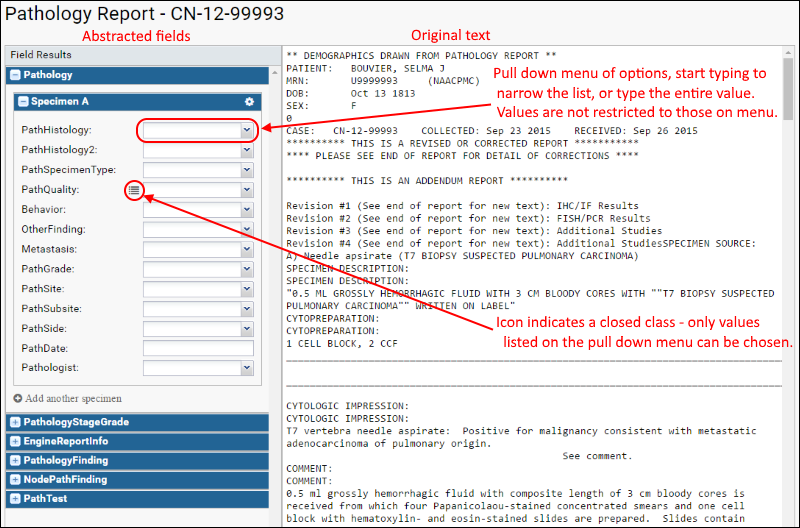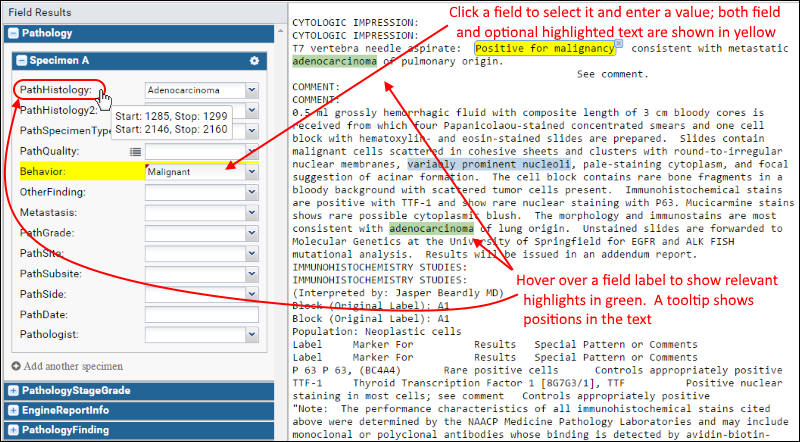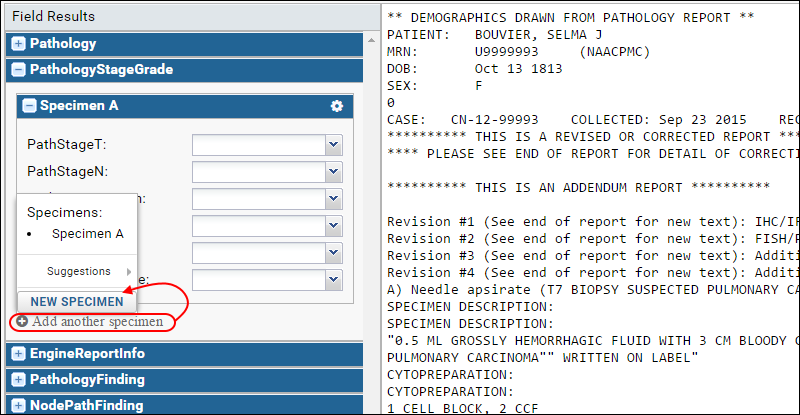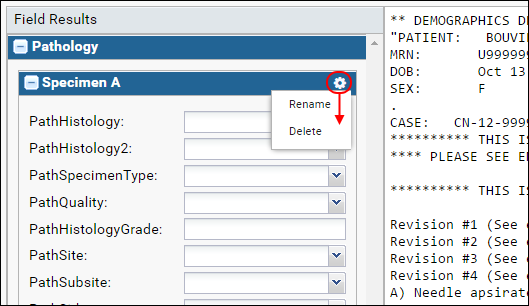Abstraction of information from clinical documents into tabular data needs to be done efficiently and accurately, and can unearth in a wealth of previously untapped data for integration and analysis. An NLP engine can automatically abstract information based on the type of document, and further manual abstraction by one or more people using the process covered here can maximize information extraction.
Abstraction Task List
The assigned user must have "Abstractor" permissions and will initiate a manual abstraction by clicking
Abstract on the task list.

The task list grid can be sorted and filtered as desired, and grid views saved for future use. After completion of a manual abstraction, the user will advance to the next document in the user's default view of the task list.
Abstraction UI
The document abstraction UI is shown in two panels. The imported text on the right can be scrolled, highlighted, and reviewed for key information. The left hand panel shows a list of field results into which information found in the text will be abstracted. The fields are organized in categories that can vary based on the document type. For example, Pathology Report field categories include:
- Pathology
- Pathology/Stage/Grade
- Engine Report Info
- Pathology Finding
- Node Path Finding
- Path Test

If an automated abstraction pass is done prior to manual abstraction, pulldowns may be prepopulated with information gathered by the abstraction (NLP) engine. In particular, if the disease group can be identified, this can narrow the set of values for each field offered to a manual abstractor. The type of document also drives some decisions about how to interpret parts of the text. By default, the first table and specimen are expanded when the abstractor first opens the UI.
The abstractor scans for relevant details in the text, selects or enters information in the field in the results section, and can highlight one or more relevant pieces of text on the right. Some fields allow free text entry, other fields use pulldowns offering a set of possible values.
Expand and contract field category sections by clicking the title bars. Select a field by clicking the label; the selected row will show in yellow, as will any associated text highlights previously added for that field. Choose a value from the menu, start typing to narrow the options, or keep typing to enter free text as appropriate. There are two types of fields with pulldown menus. Open-class fields allow you to either select a listed value or enter a new one of your own; closed-class fields require a selection of one of the listed values. You can still type to enter the value, but only matching values will be accepted.
At any point you can highlight a string of text in the right hand panel to associate with the currently selected field. If you do so before entering a value for the field, the selected text will be entered as the value if possible. For a free text field, the entry is automatic. For a field with a pulldown menu, if you highlight a string in the text that matches a value on the given menu, it will be selected. If you had previously entered a different value, however, that earlier selection takes precedence and is not superceded by later text highlighting. You may multi-select several regions of text for any given field result as needed.
In the following screenshot, several types of text highlighting are shown. When you click to select a field, the field and any associated highlights are colored yellow. If you double-click the field label, the text panel will be scrolled to place the first highlighted region within the visible window, typically three rows from the top. Shown selected here, the text "Positive for malignancy" was just linked to the active field Behavior with the value "Malignant". Also shown here, when you hover over the label or value for a field which is
not active, in this case "PathHistology" the associated highlighted region(s) of text will be shown in green.

Text that has been highlighted for a field that is neither active (yellow) nor hovered-over (green) is shown in light blue. Click on any highlighting to activate the associated field and show both in yellow.
A given region of text can also be associated with multiple field results. The count of related fields is shown with the highlight region ("1 of 2" for instance).
Unsaved changes are indicated by red corners on the entered fields. If you make a mistake or wish to remove highlighting on the right, click the 'x' attached to the highlight region.
Save work in progress any time by clicking
Save Draft. If you leave the abstraction UI, you will still see the document as a task waiting to be completed, and see the message "Initial abstraction in progress". When you return to an abstraction in progress, you will see previous highlighting, selections, and can continue to review and abstract more of the document.
Once you have completed the abstraction of the entire document, you will click
Submit to close your task and pass the document on for review, or if no review is selected, the document will be considered completed and approved.
When you submit the document, you will automatically advance to the next document assigned for you to abstract, according to the sort order established on your default view of your task list. There is no need to return to your task list explicitly to advance to the next task.
Multiple Specimens per Document
There may be information about multiple specimens in a single document. Each field results category can have multiple panels of fields, one for each specimen. To add information for an additional specimen, open the relevant category in the field results panel, then click
Add another specimen and select
New Specimen from the menu.

Once you have defined multiple specimens for the document, you can use the same menu to select among them.
Specimen names can be changed and specimens deleted from the abstraction using the cog icon for each specimen panel.

Reopen an Abstraction Task
If you mistakenly approve a document too quickly, you can use the back button in your browser to return to it. Click
Reopen to return it to an unapproved status.